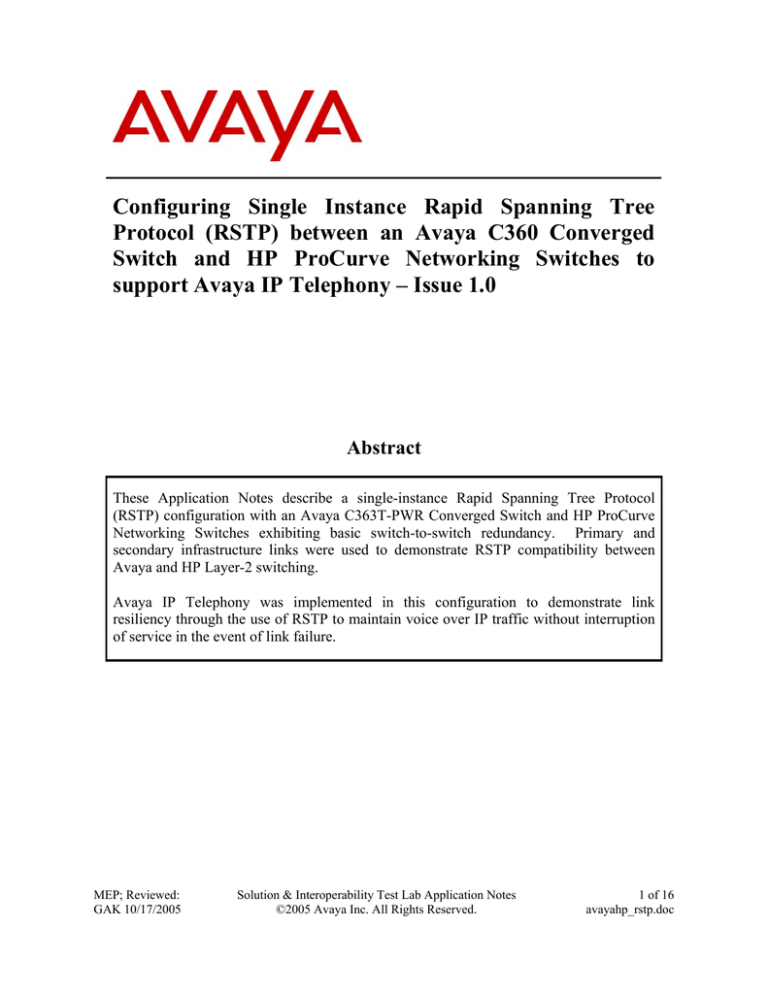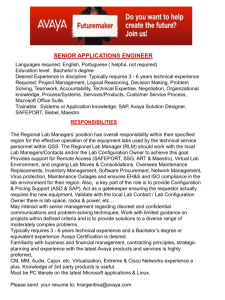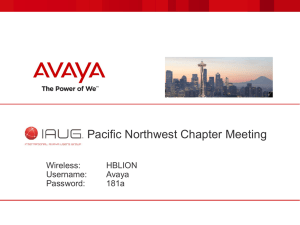
Configuring Single Instance Rapid Spanning Tree
Protocol (RSTP) between an Avaya C360 Converged
Switch and HP ProCurve Networking Switches to
support Avaya IP Telephony – Issue 1.0
Abstract
These Application Notes describe a single-instance Rapid Spanning Tree Protocol
(RSTP) configuration with an Avaya C363T-PWR Converged Switch and HP ProCurve
Networking Switches exhibiting basic switch-to-switch redundancy. Primary and
secondary infrastructure links were used to demonstrate RSTP compatibility between
Avaya and HP Layer-2 switching.
Avaya IP Telephony was implemented in this configuration to demonstrate link
resiliency through the use of RSTP to maintain voice over IP traffic without interruption
of service in the event of link failure.
MEP; Reviewed:
GAK 10/17/2005
Solution & Interoperability Test Lab Application Notes
©2005 Avaya Inc. All Rights Reserved.
1 of 16
avayahp_rstp.doc
1. Introduction
The IEEE 802.1w Rapid Spanning Tree Protocol (RSTP) was developed to decrease the
recovery time of redundant paths in Layer 2 networks and reduce the impact of accidental
network loops. RSTP can reduce the spanning tree convergence time to 5 seconds or less
to establish a network path and reduce network downtime.
The IEEE 802.1d root port and designated port roles used in normal spanning-tree
operation remain the same in rapid spanning-tree. However the blocking port role is now
split into backup and alternate port roles. The alternate port provides an alternate path in
the direction of the root bridge in the event that the root port fails.
In the network diagram depicted in Figure 1, all switches configured are connected by
1000 Base SX links as redundancy pairs. When a link becomes out of service, the
redundant link will become active to maintain Layer-2 connectivity.
The HP ProCurve 5304XL will provide IP routing to enable multi-VLAN connectivity
between the Avaya C363T-PWR Converged Switch, the Avaya G350 Media Gateway
and the HP ProCurve 2626-PWR Networking Switch. A DHCP server was configured
with multiple scopes to provide IP addressing and registration parameters for the Avaya
IP Telephones connected to the edge switches.
Figure 1: Network Diagram for RSTP Configuration
MEP; Reviewed:
GAK 10/17/2005
Solution & Interoperability Test Lab Application Notes
©2005 Avaya Inc. All Rights Reserved.
2 of 16
avayahp_rstp.doc
2. Equipment and Software Validated
The following equipment and software were used for the sample configuration provided:
Equipment
Avaya C363T-PWR Converged Switch
Avaya G350 Media Gateway
Avaya S8300 Media Server
Avaya 4620 IP Telephone
HP ProCurve 5304XL Networking Switch
HP ProCurve 2626-PWR Networking Switch
Microsoft DHCP Server
Software
4.5.14
24.17
v340.3
v2.2
E.10.01
H.08.69
v4.0
3. Rapid Spanning Tree 802.1w Approach
The Avaya C363T-PWR Converged Switch and Avaya G350 Media Gateway support an
implementation of RSTP that is compatible with the IEEE 802.1d standard and does not
support per VLAN RSTP. This means that Avaya C363T-PWR Converged Switch and
Avaya G350 Media Gateway will send out and expect to receive untagged RSTP
messages. Therefore, all the switches configured must use the standard IEEE 802.1d for
RSTP compatibility.
Directly connected trunk ports between switches are explicitly configured as point-topoint for fast convergence and as non-edge ports. All access ports for shared media are
explicitly configured to be edge ports to transition rapidly to forwarding state when the
link becomes in-service. If the port detects a BPDU from another bridge, the operational
edge port will transition to ‘false’ and the port will participate in the topology.
To assist with the understanding of the output from show commands, the HP ProCurve
5304XL Networking Switch is configured as a root bridge with STP priority 0. The
Avaya C363T-PWR Converged Switch is configured as a first backup bridge with STP
priority 4096 and the HP ProCurve 2626-PWR Networking Switch is configured as
second backup bridge with STP priority 8192. The Avaya G350 Media Gateway is
configured with a low STP priority to avoiding challenging the switches configured as
root and backup bridges. Note that a lower value translates to higher root bridge
precedence.
4. Avaya C363T-PWR Switch Configuration
Start a terminal session to the Avaya C363T-PWR Converged Switch and log into the
console using valid login credentials. Listed below are the configuration steps used to
enable RSTP:
MEP; Reviewed:
GAK 10/17/2005
Solution & Interoperability Test Lab Application Notes
©2005 Avaya Inc. All Rights Reserved.
3 of 16
avayahp_rstp.doc
Create the Virtual LANs on the switch. Assign the native VLAN to edge ports
and statically assign the voice VLAN on the same edge ports to allow broadcasts
from either VLAN. This procedure provides the flexibility of connecting either
an Avaya IP Telephone, stand-alone PC or both to a configured edge port.
set
set
set
set
vlan
vlan
port
port
40 name vlan40
60 name vlan60
vlan 40 1/1
static-vlan 1/1 60
Optionally, dot1q trunking can be enabled on the edge port connecting the
Avaya IP Telephone with inline PC to accept tagged frames and forward
untagged frames to the native VLAN. This provides a more secure method of
segmenting VLAN broadcast domains while differentiating voice and data
traffic.
set trunk 1/1 dot1q
set port vlan-binding-mode 1/1 static
Note: An edge port configured using the alternative procedure with dot1q enabled
instead of shared access does not have the same flexibility as the initial method and
cannot accept a directly-connected PC without an Avaya IP Telephone forwarding the
untagged frames
Enable dot1q trunking on all infrastructure ports and bind the configured
VLANs. Configure IP addressing for the inband management interface and set
the default gateway.
set
set
set
set
trunk 1/51-52 dot1q
port vlan-binding-mode 1/51-52 bind-to-configured
interface inband 40 40.1.1.2 255.255.255.0
ip route 0.0.0.0 40.1.1.1
Globally enable the spanning-tree algorithm and configure the switch for RSTP
operation. Enable the default path cost for RSTP and set the RSTP priority value
as the first backup bridge to the configured root bridge.
set
set
set
set
spantree
spantree
spantree
spantree
MEP; Reviewed:
GAK 10/17/2005
enable
version rapid-spanning-tree
default-path-cost rapid-spanning-tree
priority 4096
Solution & Interoperability Test Lab Application Notes
©2005 Avaya Inc. All Rights Reserved.
4 of 16
avayahp_rstp.doc
Set the infrastructure ports as non-edge ports and force point-to-point MAC
address forwarding. Set the classification of the infrastructure ports to valuable
to erase all learned MAC addressing during changes in RSTP state.
set port edge admin state 1/51-52 non-edge-port
set port point-to-point admin status 1/51-52 force-true
set port classification 1/51-52 valuable
Set all ports designated for shared media as edge ports and disable point-to-point
MAC forwarding. Set the classification of the infrastructure ports to regular to
maintain all learned MAC addressing during changes in RSTP state
set port edge admin state 1/1 edge-port
set port point-to-point admin status 1/1 force-false
set port classification 1/1 regular
5. HP ProCurve 5304XL Switch Configuration
Start a terminal session to the HP ProCurve 5304XL Switch and log into the console
using valid login credentials. Listed below are the steps used to configure RSTP on the
HP ProCurve 5304XL Switch:
Create a Virtual LAN on the switch and configure an IP address for each VLAN
Enable IP routing to route traffic between VLANs.
vlan 30
ip address 30.1.1.1 255.255.255.0
vlan 40
ip address 40.1.1.1 255.255.255.0
vlan 50
ip address 50.1.1.1 255.255.255.0
vlan 60
ip address 60.1.1.1 255.255.255.0
ip routing
MEP; Reviewed:
GAK 10/17/2005
Solution & Interoperability Test Lab Application Notes
©2005 Avaya Inc. All Rights Reserved.
5 of 16
avayahp_rstp.doc
Configure infrastructure ports as tagged ports to enable 802.1Q trunking and
configure edge ports hosting shared media as untagged ports. Configure the IP
address of the DHCP Server on each VLANs designated to forward DHCP
requests to IP Telephone and attached PCs.
vlan 30
tagged A1-A2
ip helper-address 50.1.1.50
vlan 40
tagged A3-A4
ip helper-address 50.1.1.50
vlan 50
untagged B1-B2, B5
vlan 60
tagged A1-A4, B1-B2
ip helper-address 50.1.1.50
Note: The DHCP relay parameter on the HP ProCurve 5304XL Networking Switch is
enabled by default
Globally enable the spanning-tree algorithm. Configure the switch to use RSTP
as the spanning-tree protocol and force RSTP compatibility. Set a RSTP priority
value of zero to force the switch to assume root bridge.
spanning-tree
spanning-tree force-version rstp
spanning-tree protocol-version rstp
spanning-tree priority 0
Disable edge port feature on all switch-to-switch trunk ports and enable each link
as point-to-point.
no spanning-tree ethernet a1-a4, b1-b2 edge-port
spanning-tree ethernet a1-a4, b1-b2 point-to-point-mac force-true
Designate shared LAN segments as edge ports and disable point-to-point
forwarding of MAC addressing.
spanning-tree ethernet b5 edge-port
spanning-tree ethernet b5 point-to-point-mac force-false
MEP; Reviewed:
GAK 10/17/2005
Solution & Interoperability Test Lab Application Notes
©2005 Avaya Inc. All Rights Reserved.
6 of 16
avayahp_rstp.doc
6. HP ProCurve 2626-PWR Switch Configuration
Start a terminal session to the HP ProCurve 2626-PWR Switch and log into the console
using valid login credentials. Listed below are the steps used to configure RSTP on the
HP ProCurve 2626-PWR Switch:
Create Virtual LANs on the switch and configure an IP address for the primary
VLAN. The primary VLAN is dedicated for management features and must be
configured in order to propagate DHCP-resolved parameters to the correct
VLAN.
vlan 30
ip address 30.1.1.2 255.255.255.0
vlan 60
primary-vlan 30
Configure infrastructure ports as tagged ports to enable 802.1Q trunking and
configure edge ports hosting shared media as untagged ports. Set the default
gateway.
vlan 30
tagged 25-26
untagged 1
vlan 60
tagged 1,25-26
ip default-gateway 30.1.1.1
Globally enable the spanning-tree algorithm. Configure the switch to use RSTP
as the spanning-tree protocol and force RSTP compatibility. Set the RSTP
priority value as the second backup bridge to the configured root bridge.
spanning-tree
spanning-tree protocol-version rstp
spanning-tree force-version rstp
spanning-tree priority 2
Note: HP ProCurve 2626-PWR uses single-digits to segment and administer priority
settings instead of segments of 4096 (4096 * 2 = 8192).
MEP; Reviewed:
GAK 10/17/2005
Solution & Interoperability Test Lab Application Notes
©2005 Avaya Inc. All Rights Reserved.
7 of 16
avayahp_rstp.doc
Disable the edge port feature on all switch-to-switch trunk ports and enable each
link as point-to-point.
no spanning-tree ethernet 25-26 edge-port
spanning-tree ethernet 25-26 point-to-point-mac force-true
Designate shared LAN segments as edge ports and disable point-to-point
forwarding of MAC addressing.
spanning-tree ethernet 1 edge-port
spanning-tree ethernet 1 point-to-point-mac force-false
7. Avaya Communication Manager
The Avaya G350 Media Gateway will be used to forward Voice over IP traffic and
control IP Phone registration in conjunction with the Avaya S8300 Media Server.
7.1. Avaya G350 Media Gateway
Start a terminal session to the Avaya G350 Media Gateway and log into the console using
valid login credentials. Listed below are the steps used to configure RSTP on the Avaya
G350 Media Gateway:
Create the assigned data and voice VLANs on the G350 switch. Enable dot1q
trunking on the LAN ports and bind the configured VLANs
set
set
set
set
vlan 50 name vlan50
vlan 60 name vlan60
trunk 6/1-2 dot1q
port vlan-binding-mode 6/1-2 bind-to-configured
Configure IP addressing for the inband VLAN interface designated as the
primary management interface. Configure the VLAN hosting the Avaya S8300
Media Server as the ICC VLAN
interface Vlan 50
ip address 50.1.1.5 255.255.255.0
pmi
interface Vlan 60
icc-vlan
MEP; Reviewed:
GAK 10/17/2005
Solution & Interoperability Test Lab Application Notes
©2005 Avaya Inc. All Rights Reserved.
8 of 16
avayahp_rstp.doc
Globally enable the spanning-tree algorithm and configure the G350 Media
Gateway for RSTP operation. Enable the default path cost for RSTP and set a
high RSTP priority value to ensure the G350 does not assume a backup role to
the configured root bridge.
set
set
set
set
spantree
spantree
spantree
spantree
enable
version rapid-spanning-tree
default-path-cost rapid-spanning-tree
priority 61440
Set the connected LAN ports on the G350 Media Gateway as non-edge and force
point-to-point MAC address forwarding.
Set the classification of the
infrastructure ports to valuable to erase all learned MAC addressing during
changes in RSTP state.
set port edge admin state 6/1-2 non-edge-port
set port point-to-point admin status 6/1-2 force-true
set port classification 6/1-2 valuable
Add the IP address of the Avaya S8300 Media Server communicating with
Avaya G350 Media Gateway and set the default gateway.
set mgc list 60.1.1.5
ip default-gateway 50.1.1.1
7.2. Avaya S8300 Media Server
For brevity, this section will assume the viewer of these Application Notes has a
fundamental understanding of Avaya IP Telephony and will not cover details regarding
the configuration of Avaya Communication Manager. See the additional references in
Section 10 for further information.
7.3. DHCP registration for Avaya 4620 IP Telephone
A Microsoft DHCP Server was used by the Avaya 4620 IP Telephones to register with
the Avaya S8300 Media Server. Three separate scopes were used for DHCP registration:
two for data (VLAN 30 and VLAN 40) and one for voice (VLAN 60). In addition to IP
addressing and dot1q tagging, another option was created for the voice VLAN to define
the call server and call server port for phone registration.
MEP; Reviewed:
GAK 10/17/2005
Solution & Interoperability Test Lab Application Notes
©2005 Avaya Inc. All Rights Reserved.
9 of 16
avayahp_rstp.doc
The following scopes were defined on the Microsoft DHCP Server for each VLAN:
Scope [30.1.1.0] Data VLAN 30
Address Pool:
Start Address: 30.1.1.100
End Address: 30.1.1.110
Subnet mask: 255.255.255.0
Option 003 Router: 30.1.1.1
Option 176 Avaya Option: L2Q=1,L2QVLAN=60
Scope [40.1.1.0] Data VLAN 40
Address Pool:
Start Address: 40.1.1.100
End Address: 40.1.1.110
Subnet mask: 255.255.255.0
Option 003 Router: 40.1.1.1
Option 176 Avaya Option: L2Q=1,L2QVLAN=60
Scope [60.1.1.0] Voice VLAN
Address Pool:
Start Address: 60.1.1.100
End Address: 60.1.1.110
Subnet mask: 255.255.255.0
Option 003 Router: 60.1.1.1
Option 176 Avaya Option: MCIPADD=60.1.1.5,MCPORT=1719
8. Verification
These Application Notes were confirmed using the verification and troubleshooting
commands listed in the individual switch configuration section. While there is one path in
the network, traffic from edge nodes should pass and network interruption should be less
than 5 seconds. If a ping fails or the network interruption is more than 5 seconds, use the
troubleshooting commands in the configuration section for each switch to isolate the
problem.
1. After connecting either configuration depicted, verify that no loops have occurred by
using vendor-specific RSTP commands and viewing interface statistics.
2. Disconnect primary links and observe that the redundant links become active and
rapidly transition to the forwarding state. Convergence times should be on the order
of 5 seconds or less.
3. Reconnect previously disconnect primary links and observe the transition to the
forwarding state and the corresponding redundant links transition to the blocking
state.
8.1. Avaya C363T-PWR RSTP Verification
The following show commands will provide RSTP status information for the Avaya
C363T-PWR Converged Switch:
MEP; Reviewed:
GAK 10/17/2005
Solution & Interoperability Test Lab Application Notes
©2005 Avaya Inc. All Rights Reserved.
10 of 16
avayahp_rstp.doc
show spanning-tree
Spanning tree state is enabled
Designated Root: 00-08-83-74-62-00
Designated Root Priority: 0
Designated Root Cost: 20000
Designated Root Port: 1/51
Root Max Age: 20
Hello Time: 2
Root Forward Delay: 15
Bridge ID MAC ADDR: 00-04-0d-3f-91-ff
Bridge ID priority: 4096
Bridge Max Age: 20
Bridge Hello Time: 2
Bridge Forward Delay: 15 Tx Hold Count 3
Spanning Tree Version is rapid spanning tree
Spanning Tree Default Path Costs is according to rapid spanning tree
Port
State
Cost
Priority
------ ------------- ---------- -----------1 /1
Forwarding
200000
128
--- Output omitted --1 /51
1 /52
Forwarding
Blocking
20000
20000
128
128
show port classification
Port
Port Classification
------ --------------------1/1
regular
--- Output omitted --1/51
1/52
valuable
valuable
show port edge state
Port
------1/1
admin state
------------edge-port
oper state
------------edge-port
--- Output omitted --1/51
1/52
non-edge-port
non-edge-port
MEP; Reviewed:
GAK 10/17/2005
non-edge-port
non-edge-port
Solution & Interoperability Test Lab Application Notes
©2005 Avaya Inc. All Rights Reserved.
11 of 16
avayahp_rstp.doc
show port point-to-point status
Port
------1/1
point-to-point admin state
---------------------------force-false
point-to-point oper state
-------------------------shared media connection
--- Output omitted --1/51
1/52
force-true
force-true
point to point connection
point to point connection
8.2. Avaya G350 Media Gateway RSTP Verification
The following show commands will provide RSTP status information for the Avaya G350
Media Gateway:
show spanning-tree
Designated Root: 00-08-83-74-62-00
Designated Root Priority: 0
Designated Root Cost: 200000
Designated Root Port: 6/1
Root Max Age: 20
Hello Time: 2
Root Forward Delay: 15
Bridge ID MAC ADDR: 00-04-0d-29-d2-f6
Bridge ID priority: 61440
Bridge Max Age: 20
Bridge Hello Time: 2
Bridge Forward Delay: 15 Tx Hold Count 3
Spanning Tree Version is rapid spanning tree
Spanning Tree Default Path Costs is according to rapid spanning tree
show port classification
Port
Port Classification
------ --------------------6/1
valuable
6/2
valuable
show port point-to-point status
Port
------6/1
6/2
point-to-point admin state
---------------------------force-true
force-true
MEP; Reviewed:
GAK 10/17/2005
point-to-point oper state
-------------------------point to point connection
point to point connection
Solution & Interoperability Test Lab Application Notes
©2005 Avaya Inc. All Rights Reserved.
12 of 16
avayahp_rstp.doc
8.3. HP ProCurve 5304XL RSTP Verification
The following show commands will provide RSTP status information for the HP
ProCurve 5304XL Networking Switch:
show spanning-tree
STP Enabled : Yes
Force Version : RSTP-operation
Switch Priority : 0
Max Age : 20
Hello Time : 2
Forward Delay : 15
Topology Change Count : 9
Time Since Last Change : 2 days
Root
Root
Root
Root
MAC Address : 000883-746200
Path Cost : 0
Port : This switch is root
Priority : 0
Port
---A1
A2
A3
A4
Type
--------1000SX
1000SX
1000SX
1000SX
Cost
--------20000
20000
20000
20000
Priority
-------128
128
128
128
State
---------Forwarding
Forwarding
Forwarding
Forwarding
|
+
|
|
|
|
Designated Bridge
----------------000883-746200
000883-746200
000883-746200
000883-746200
show spanning-tree config detail
STP Enabled [No] : Yes
Force Version [RSTP-operation] : RSTP-operation
Switch Priority [8] : 0
Hello Time [2] : 2
Max Age [20] : 20
Forward Delay [15] : 15
Port
---A1
A2
A1
A2
Type
--------1000SX
1000SX
1000SX
1000SX
|
+
|
|
|
|
Cost
--------20000
20000
20000
20000
Priority
-------8
8
8
8
Edge
---No
No
No
No
Point-to-Point
-------------Force-True
Force-True
Force-True
Force-True
MCheck
-----Yes
Yes
Yes
Yes
--- Output omitted --B1
10/100TX
MEP; Reviewed:
GAK 10/17/2005
| 200000
8
Yes
Force-False
Yes
Solution & Interoperability Test Lab Application Notes
©2005 Avaya Inc. All Rights Reserved.
13 of 16
avayahp_rstp.doc
8.4. HP ProCurve 2626-PWR RSTP Verification
The following show commands will provide RSTP status information for the HP
ProCurve 2626-PWR Networking Switch:
show spanning-tree
STP Enabled : Yes
Force Version : RSTP-operation
Switch Priority : 8192
Max Age : 20
Hello Time : 2
Forward Delay : 15
Topology Change Count : 9
Time Since Last Change : 2 days
Root
Root
Root
Root
MAC Address : 000883-746200
Path Cost : 0
Port : 25
Priority : 0
Port Type
Cost
Priority State
| Designated Bridge
---- --------- --------- -------- ---------- + ------------------- Output omitted --25
26
1000SX
1000SX
20000
20000
128
128
Forwarding | 000883-746200
Blocking
| 000883-746200
show spanning-tree config detail
STP Enabled [No] : Yes
Force Version [RSTP-operation] : RSTP-operation
Switch Priority [8] : 8192
Hello Time [2] : 2
Max Age [20] : 20
Forward Delay [15] : 15
Port Type
| Cost
Priority Edge Point-to-Point MCheck
---- --------- + --------- -------- ---- -------------- -----1
10/100TX | 200000
8
Yes Force-False
Yes
--- Output omitted --25
26
1000SX
1000SX
MEP; Reviewed:
GAK 10/17/2005
| 20000
| 20000
8
8
No
No
Force-True
Force-True
Yes
Yes
Solution & Interoperability Test Lab Application Notes
©2005 Avaya Inc. All Rights Reserved.
14 of 16
avayahp_rstp.doc
9. Conclusion
Single-instance RSTP operation between the Avaya C363T-PWR Converged Switch, the
Avaya G350 Media Gateway and HP ProCurve Switches is compatible and a fast
convergence time (less than 5 seconds) can be achieved in case of link failure.
Connectivity between all of the vendors’ products depicted using 802.1w Rapid Spanning
Tree Protocol (RSTP) can be achieved by following the guidelines demonstrated in these
Application Notes.
10. Additional References
The following reference documents can be obtained online:
From http://support.avaya.com:
•
•
Avaya C360 Converged Switch User Guide
Administrator’s Guide for Avaya Communication Manager
From http://www.hp.com/rnd/support
•
HP Advanced Traffic Management Guide
MEP; Reviewed:
GAK 10/17/2005
Solution & Interoperability Test Lab Application Notes
©2005 Avaya Inc. All Rights Reserved.
15 of 16
avayahp_rstp.doc
©2005 Avaya Inc. All Rights Reserved.
Avaya and the Avaya Logo are trademarks of Avaya Inc. All trademarks identified by ®
and are registered trademarks or trademarks, respectively, of Avaya Inc. All other
trademarks are the property of their respective owners. The information provided in
these Application Notes is subject to change without notice. The configurations,
technical data, and recommendations provided in these Application Notes are believed to
be accurate and dependable, but are presented without express or implied warranty.
Users are responsible for their application of any products specified in these Application
Notes.
Please e-mail any questions or comments pertaining to these Application Notes along
with the full title name and filename, located in the lower right corner, directly to the
Avaya Solution & Interoperability Test Lab at interoplabnotes@list.avaya.com
MEP; Reviewed:
GAK 10/17/2005
Solution & Interoperability Test Lab Application Notes
©2005 Avaya Inc. All Rights Reserved.
16 of 16
avayahp_rstp.doc



